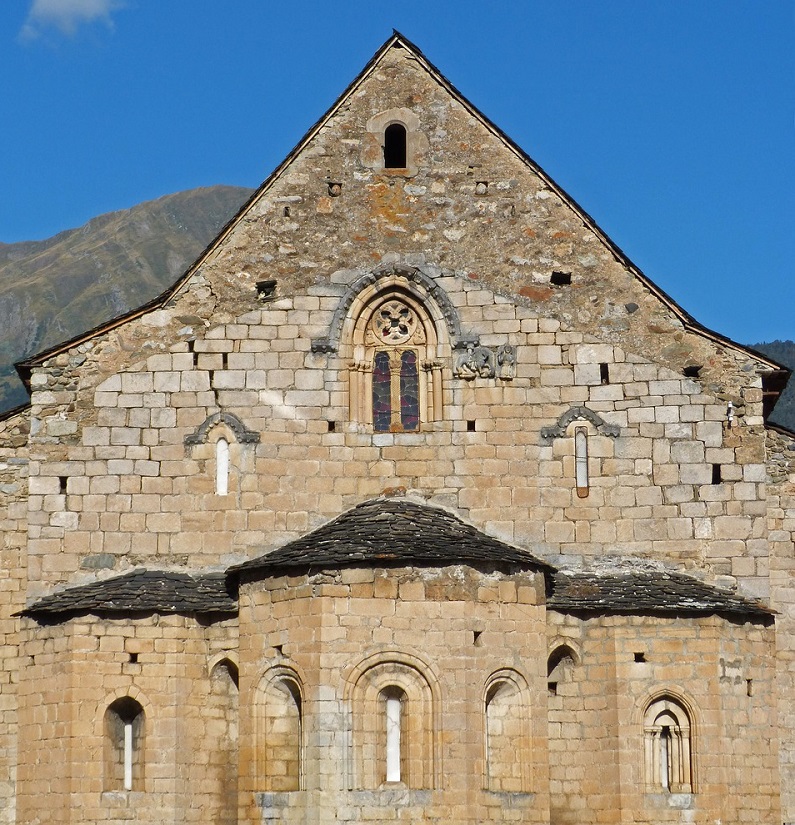Apse

|
| A triple-apsed, polygonal termination of a church in Tredos. |
Apses were first used in pre-Christian Roman architecture, often as a niche to contain the statue of a deity. They were also used in the thermae – the large bath complexes of imperial Rome.
From the fourth century onwards in Christian architecture, the basilica (an important church with rectangular plan) would sometimes be terminated at one end (normally the liturgical east end) with an apse – a semi-circular or polygonal recess. Sometimes the apse would be topped by a hemi-spherical or quarter dome that would often be vaulted on the inside. However, the roof might also have been flat or sloping.
The use of the apse would progress in Christian religious architecture as a single or multiple termination for naves, transepts or aisles.
Apses were to become common in Byzantine architecture, as well as in France, Germany and Italy. In a cruciform church or cathedral plan, whether in Western Romanesque or Gothic, apses would later be used to terminate the transepts and nave whether as single or multiple-apsed ends. They could also be used as a chapel or part of the chancel.
In England, apses were sometimes added as semi-circular forms applied to the east end of Romanesque churches. This changed mostly to a polygonal form during the Gothic period.
Apses underwent a revival during the Victorian period with its Greek-, Roman- and Gothic-revival periods.
[edit] Related articles on Designing Buildings
Featured articles and news
RTPI leader to become new CIOB Chief Executive Officer
Dr Victoria Hills MRTPI, FICE to take over after Caroline Gumble’s departure.
Social and affordable housing, a long term plan for delivery
The “Delivering a Decade of Renewal for Social and Affordable Housing” strategy sets out future path.
A change to adoptive architecture
Effects of global weather warming on architectural detailing, material choice and human interaction.
The proposed publicly owned and backed subsidiary of Homes England, to facilitate new homes.
How big is the problem and what can we do to mitigate the effects?
Overheating guidance and tools for building designers
A number of cool guides to help with the heat.
The UK's Modern Industrial Strategy: A 10 year plan
Previous consultation criticism, current key elements and general support with some persisting reservations.
Building Safety Regulator reforms
New roles, new staff and a new fast track service pave the way for a single construction regulator.
Architectural Technologist CPDs and Communications
CIAT CPD… and how you can do it!
Cooling centres and cool spaces
Managing extreme heat in cities by directing the public to places for heat stress relief and water sources.
Winter gardens: A brief history and warm variations
Extending the season with glass in different forms and terms.
Restoring Great Yarmouth's Winter Gardens
Transforming one of the least sustainable constructions imaginable.
Construction Skills Mission Board launch sector drive
Newly formed government and industry collaboration set strategy for recruiting an additional 100,000 construction workers a year.
New Architects Code comes into effect in September 2025
ARB Architects Code of Conduct and Practice available with ongoing consultation regarding guidance.
Welsh Skills Body (Medr) launches ambitious plan
The new skills body brings together funding and regulation of tertiary education and research for the devolved nation.
Paul Gandy FCIOB announced as next CIOB President
Former Tilbury Douglas CEO takes helm.
UK Infrastructure: A 10 Year Strategy. In brief with reactions
With the National Infrastructure and Service Transformation Authority (NISTA).






















